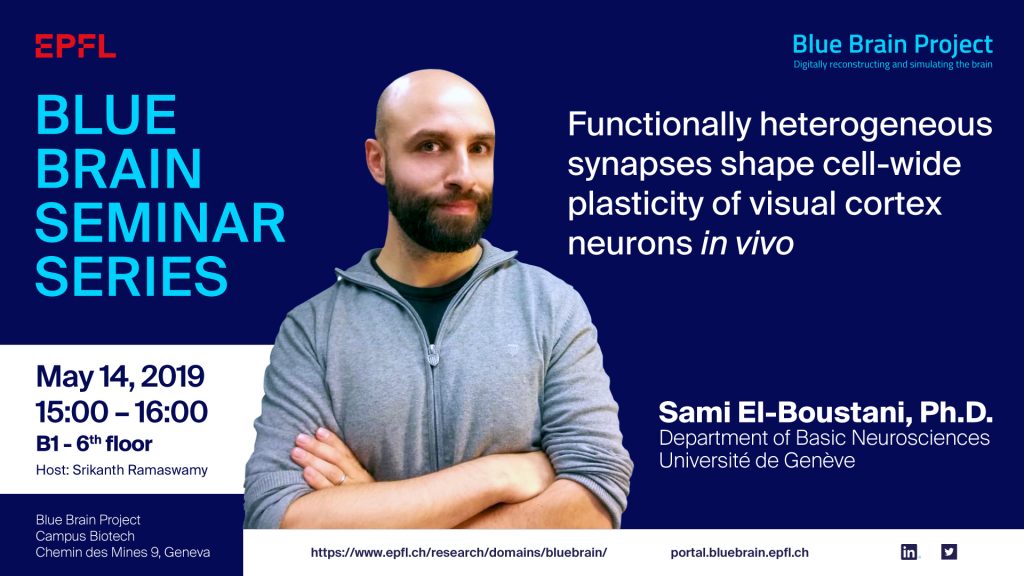
Blue Brain is delighted to announce the next seminar in the series in Neural Computation, in which we welcome as our second speaker, Sami El-Boustani from the University of Geneva.
Sami will present ‘Functionally heterogeneous synapses shape cell-wide plasticity of visual cortex neurons in vivo.’
Bio: Sami El-Boustani obtained his PhD in neuroscience from Sorbonne University in 2011, working with Alain Destexhe (CNRS, France) on computational models of cortical dynamics. He then joined the laboratories of Mriganka Sur (MIT, USA) as a postdoctoral fellow to study the function of specific interneurons cell-types in the primary visual cortex as well as mechanisms of dendritic plasticity. After a second postdoctoral position with Carl Petersen (EPFL, Switzerland) working on whisker-based perceptual decision-making, he was awarded a SNSF Eccellenza Professorial fellowship to start his own lab in the Department of Basic Neurosciences at the University of Geneva.
Abstract: Neuronal circuits in the developing and mature brain are subject to dramatic changes driven by sensory inputs or motor learning, causing individual cells to modify their responses to individual inputs while maintaining a relatively stable level of overall activity. Cell-wide homeostatic plasticity was initially reported as a global mechanism for stabilizing the output firing rate of a cell by uniformly scaling up or down the effective strength of all its synapses. More recent experimental evidence in vitro has suggested the existence of local homeostatic mechanisms acting at the level of dendritic stretches or even at single synapses that would potentially confer rich functional compartmentalization within the dendritic tree. However, the existence and nature of local compensatory plasticity in vivo and its implications for the coherent reorganization of single cell responses remains unexplored. In particular, it has been pointed out that the joint action of Hebbian and homeostatic plasticity in synaptic ensembles could impede the formation of new functions by cancelling each other. Here we have used visual-optogenetic pairing to demonstrate that induction of receptive field plasticity in single visual cortex neurons of awake mice alters identified synapses on neuronal dendrites. Such plasticity potentiates specific synapses and depresses others within short stretches of the same dendrite, consistent with functionally heterogeneous local sets of synapses that convey diverse receptive field inputs to a neuron. Crucially, depressed spines lie in close proximity to potentiated spines, indicating coordinated Hebbian and heterosynaptic long-term depression in vivo that involves neighboring synapses. AMPA receptors are trafficked into potentiated spines and removed from depressed spines via targeted expression of the immediate early gene product Arc in the latter spines. Locally coordinated potentiation and depression of spines, mediated by Arc, also underlies functional changes in eye-specific responses of visual cortex neurons following monocular deprivation and recovery. The spatially local distribution of depressed spines around potentiated spines, in conjunction with functionally intermixed synaptic inputs to dendrites, demonstrates a powerful new mechanism that organizes cell-wide plasticity with local dendritic interactions.
The seminar is an open event, at the Blue Brain offices in the Campus Biotech, Geneva. Upon arrival at the Campus Biotech, please sign in at the Campus Biotech reception.
Tuesday 14 May 2019
15:00-16:00
Blue Brain Project
Campus Biotech
Chemin des Mines 9
Geneva
Host: Srikanth Ramaswamy, Senior Scientist, Blue Brain Project
For more information, please contact [email protected]
How to get to the Seminar – https://www.epfl.ch/research/domains/bluebrain/blue-brain/contact/